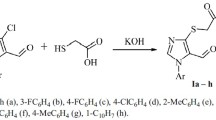Abstract
Parenteral administration of mercuric chloride (HgCl2) to rats enhanced lipid peroxidation in liver, kidney, lung, testis, and serum (but not in heart, spleen, or muscle), as measured by the thiobarbituric acid reaction for malondialdehyde (MDA) in fresh tissue homogenates and body fluids. After sc injection of HgCl2 (5 mg/kg body wt), MDA concentrations in liver and kidney became significantly increased by 9 h and reached peak values at 24 h. Dose-response studies were carried out with male albino rats of the Fisher-344 strain (body wt 170–280 g) injected with 1, 3, 5 mg Hg/kg as HgCl2 and sacrificed after 24 h. In time-response studies, animals were administered 5 mg Hg/kg as HgCl2 and sacrificed after 3, 9, 18, 24, and 48 h. Studies in the authors' laboratory have shown that (1) concentrations of MDA are increased in targets (liver, kidney, lung, and testis) of HgCl2-treated rats; (2) severity of hepatotoxicity and nephrotoxicity is generally consistent with the elevation of Hg and MDA concentrations, based upon the time-course and dose-effect relationships observed after administration of HgCl2 to rats; and (3) concentrations of MDA are reduced in target tissues after pretreatment with antioxidants and chelators to HgCl2-treated rats. The results of this study implicate that the lipid peroxidation is one of the molecular mechanisms for cell injury in acute HgCl2 poisoning.
Similar content being viewed by others
References
F. W. Sunderman Jr.,Acta Pharmacol. Toxicol. 59 (suppl. 7), 248–255 (1986).
J. M. C. Gutteridge and B. Halliwell,Trends Biochem. Sci. 15, 129–135 (1990).
S. H. Y. Wong, J. A. Knight, S. M. Hopfer, O. Zaharia, C. N. Leach Jr., and F. W. Sunderman Jr.,Clin. Chem. 33, 214–220 (1987).
B. Halliwell and J. M. C. Gutteridge,Biochem. J. 219, 1–14 (1984).
B. Halliwell and J. M. C. Gutteridge,Molec. Aspects Med. 8, 89–193 (1985).
M. Younes and C. P. Siegers,Biochem. Pharmacol. 33, 2001–2003 (1984).
N. Sugawara and C. Sugawara,J. Appl. Biochem. 6, 199–204 (1984).
Y. Yamane, H. Fukino, and M. Imagawa,Chem. Pharm. Bull. 25, 1509–1518 (1977).
A. Rothstein,Fed. Proc. 18, 1029–1038 (1959).
B. L. Vallee and D. D. Ulmer,Annu. Rev. Biochem. 41, 91–128 (1972).
H. Fukino, M. Hirai, Y. M. Hsueh, and Y. Yamane,Toxicol. Appl. Pharmacol. 73, 395–401 (1984).
M. Yonaha, E. Itoh, Y. Ohbayashi, and M. Uchiyama,Res. Commun. Chem. Pathol. Pharmacol. 28, 105–112 (1980).
R. C. Zalme, E. M. McDowell, R. B. Nagle, J. S. McNell, W. Flamenbaum, and B. F. Tramp,Arch. B. Cell Pathol. 22, 197–216 (1976).
W. B. Kinter and J. B. Pritchard, Altered permeability of cell membranes, inHandbook of Physiology, Reactions to Environmental Agents, D. H. K. Lee, H. L. Falk, S. D. Murphy, and S. R. Geiger, eds., Williams & Wilkins, Baltimore, Section 9, pp. 563–576 (1977).
M. Yonaha, Y. Ohbayashi, T. Ichinose, and M. Sagai,Chem. Pharm. Bull. 30, 1437–1443 (1982).
N. H. Stacey and H. Kappus,Toxicol. Appl. Pharmacol. 63, 29–35 (1982).
F. W. Sunderman Jr., A. Marzouk, S. M. Hopfer, O. Zaharia, and M. C. Reid,Ann. Clin. Lab. Sci. 15, 229–236 (1985).
J. J. Doughery and W. G. Hoekstra,Proc. Soc. Exp. Biol. Med. 169, 201–208 (1982).
O. A. Levander, V. C. Morris, and R. J. Ferretti,J. Nutri. 107, 363–372 (1977).
C. H. Gallagher,Austral. J. Exp. Biol. 40, 241–250 (1962).
J. B. Nielsen, H. R. Andersen, and O. Andersen,J. Toxicol. Environ. Health. 34, 469–483 (1991).
W. C. Sin, M. K. Wong, and Y. M. Sin,Bull. Environ. Contam. Toxicol. 42, 942–948 (1989).
K. N. Kee and Y. M. Sin,Bull. Environ. Contam. Toxicol. 48, 509–514 (1992).
M. Comporti,Lab. Invest. 53, 599–623 (1985).
S. V. S. Rana and P. R. Boora,Bull. Environ. Contam. Toxicol. 48, 120–124 (1992).
S. M. Lin, C. H. Chiang, C. L. Tseng, and M. H. Yang,Radiochem. Radioanal. Letters 56, 261–272 (1983).
Author information
Authors and Affiliations
Rights and permissions
About this article
Cite this article
Huang, Y.L., Cheng, S.L. & Lin, T.H. Lipid peroxidation in rats administrated with mercuric chloride. Biol Trace Elem Res 52, 193–206 (1996). https://doi.org/10.1007/BF02789461
Received:
Accepted:
Issue Date:
DOI: https://doi.org/10.1007/BF02789461




